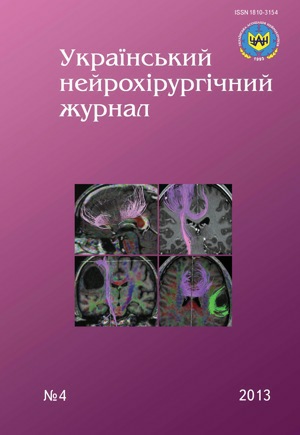Informativeness of neurophysiological diagnostic methods in the differentiation of motor neurons of spinal cord motor neuron disease
DOI:
https://doi.org/10.25305/unj.55412Keywords:
cervical spondylotic myelopathy, diagnosis, jitterAbstract
Objectives: Defining the principles and tactics of differential use of Neurophysiological (NPh) methods in cervical spondilotic myelopathy (CSM) diagnosis.
Materials and methods. Analysis of the clinical and NPh examination data of 160 patients (from 31 to 76 years of age) suffering from CSM. The examination techniques used: clinical and neurological; neurovisualizing (MRI, CT, functional spondylography); a set of NPh methods, namely: stimulation electromyography (ENMG) with F-wave recording (188 examinations); needle EMG (105); motor evoked potentials (MEP) (188); somatosensory evoked potentials (SSEP) (50); single fiber EMG with determination of average density of muscle fibers in motor units and reliability of neuromuscular transmission (32).
Results. An optimal scheme of the use of NPh diagnostic methods in patients with SCM was worked out and applied. Out of the total of 160 patients examined, 19 (11.9%) had motoneuron involved; 32 (20%) had ALS syndrome at the background of cervical spondylosis; 59 (36.9%) patients had concomitant radiculopathy, etc. The sensitivity of MEP technique in the identification of partial spinal cord compression in cervical spondylosis was confirmed – 134 (83.8%) cases; SSEP – 29 (58%). The clinical example illustrates the role of jitter-analysis in the cases when a subtle differentiation between the motoneuronal disease, ischemic and compression injury of the spinal cord motoneurons is necessary.
Conclusions. An optimal scheme of the use of NPh diagnostic methods in patients with CSM was suggested. Due to the use of motor and somatosensory evoked potential techniques, the diagnosis of the spinal cord conduction structures compression and evaluation of the degree of their functional disorders were improved. The use of jitter-analysis allows to increase the information value of NPh diagnosis of the spinal motoneuron involvment, especially at the early stages of the pathological process.
References
1. Tretyakova AI, Chebotaryova LL. Diagnostic value of neurophysiological complex “transcranial magnetic stimulation – electroneuromyography” at spondilogenic cervical myelopathy. Ukrainian Neurosurgical Journal. 2011;4:48-53. Ukrainian.
2. Tret’yakova AI, Chebotar’ova LL. Etapy elektromiohrafichnoyi diahnostyky khvorykh z shyynoyu radykulopatiyeyu [Stages electromyographic diagnosis in patients with neck radiculopathy]. Zb Nauk Prats’ Spivrobitnykiv NMAPO im PL Shupyka. 2012;21(2):580-6. Ukrainian.
3. Mumentaler M, Mattle H. Nevrologiya [Neurology]. Levin O, editor. Moscow: MEDpress-inform; 2007. Russian.
4. Kasatkina LF, Gil’vanova OV. Elektromiograficheskiye metody issledovaniya v diagnostike nervno-myshechnykh zabolevaniy. Igol'chataya elektromiografiya [Electromyographic research methods in the diagnosis of neuromuscular diseases. Needle electromyography]. Moscow: Medika; 2010. Russian.
5. Zavalishin IA, editor. Bokovoy amiotroficheskiy skleroz. Rukovodstvo dlya vrachey [Amyotrophic lateral sclerosis. Guidelines for doctors]. Moscow: GEOTAR-media; 2007. Russian.
6. Kasatkina LF. Elektromiografiya. Glava 8. Nevrologiya [Elektromiografiya. Chapter 8. Neurology]. In: Gusev YeI, Konovalov AN, S kvortsova VI, Gekht AB, editors. Natsional'noye rukovodstvo [National Guidelines]. M.: GEOTAR-Media, 2010. Russian.
7. Stalberg DV, Trontelj JV, Sanders DB. Single Fiber EMG. Uppsala: Edshagen Publ. House; 2010. 3rd ed.
8. Schwartz MS, Swash M. Pattern of involvement in the cervical segments in the early stage of motor neurone disease: a single fibre EMG study. Acta Neurol. Scand. 1982;65(5):424-31. [CrossRef]
9. Sanders DB. Single-fiber EMG. In: Zwarts MJ, Stegeman, editors. The Netherlands Course textbook DF. International SFEMG course and VIII-th Quantitative EMG congress, June 7-11, 2004. Nijmegen; 2004.
Downloads
Published
How to Cite
Issue
Section
License
Copyright (c) 2013 Albina Tretiakova, Lidiya Chebotariova

This work is licensed under a Creative Commons Attribution 4.0 International License.
Ukrainian Neurosurgical Journal abides by the CREATIVE COMMONS copyright rights and permissions for open access journals.
Authors, who are published in this Journal, agree to the following conditions:
1. The authors reserve the right to authorship of the work and pass the first publication right of this work to the Journal under the terms of Creative Commons Attribution License, which allows others to freely distribute the published research with the obligatory reference to the authors of the original work and the first publication of the work in this Journal.
2. The authors have the right to conclude separate supplement agreements that relate to non-exclusive work distribution in the form of which it has been published by the Journal (for example, to upload the work to the online storage of the Journal or publish it as part of a monograph), provided that the reference to the first publication of the work in this Journal is included.









